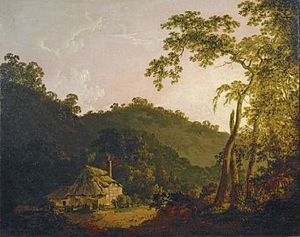Needwood Forest facts for kids
Quick facts for kids Needwood Forest |
|
|---|---|

A Cottage in Needwood Forest by Joseph Wright 1790
|
|
| Type | Woodland |
| Location | Staffordshire |
| Area | 9,437 acres (38.19 km2) |
| Created | 1266 |
| Status | Some parts remain |
Needwood Forest was a large area of ancient woodland in Staffordshire which was largely lost at the end of the 18th century.
History
The forest was on extensive lands owned by the Berkeley family of Berkeley Castle in Gloucestershire, home to extensive stocks of wild boar and fallow deer.
In the 13th century Thomas de Berkeley was assigned to be the keeper of the Tutbury ward, and while resident at Tutbury Castle liked to hunt the forest, and had a hunting lodge built, Byrkley Lodge. In 1267, Thomas married the daughter of William de Ferrers, the Earl of Derby.
During the rebellion of Simon de Montford against King Henry III, the de Ferrers family allied themselves with the rebellion. After the rebellion was put down, the de Ferrers were forced to forfeit their estates to the crown. Henry III gave the forest to his son Edmund Crouchback, 1st Earl of Lancaster, in 1266. His son Thomas, 2nd Earl of Lancaster died childless in 1322, and thus the wood passed to the King. Renamed Needwood Chase or royal forest, it was subsequently owned by the Duchy of Lancaster until it passed into the possession of Henry IV in 1399.
By this time the lodge had become the residence of the local keeper (judge). The lodge was redeveloped by King Edward IV, and used extensively for hunting by both him and King James I. It was during this period that the forest became commonly associated with Sir Gawain's Green Knight.
Enclosure and deforestation
In 1776, Francis Noel Clarke Mundy privately published a book of poetry called "Needwood Forest" which contained his own poem of the same name and supportive contributions from Sir Brooke Boothby Bt., Erasmus Darwin and Anna Seward. The purpose of Mundy's poems was to resist calls for the enclosure of the forest. Seward wrote a poem called "The fall of Needwood Forest", which she regarded as "one of the most beautiful local poems". Seward's parents adopted Honora Sneyd Edgeworth, who was probably related to the engraver, Mary Emma Sneyd. By the early 1790s, Thomas Gisborne held the perpetual curacy of Barton-under-Needwood. Gisborne regarded Needwood much as Gilbert White did Selborne, and wrote of his walks in the forest to resist enclosure.
However, in 1803 an Act of Parliament was passed, allowing the forestry commissioners to enclose the lands and deforest it. By 1811 the land had been divided amongst a number of claimants. By 1851 Needwood Forest was described as forming "one of the most beautiful and highly cultivated territories in the honour of Tutbury, which contains 9,437 acres (38.19 km2) of land, in the five parishes of Hanbury, Tutbury, Tatenhill, Yoxall, and Rolleston, and subdivided into the four wards of Tutbury, Barton, Marchington, and Yoxall, which together form a district of over seven miles (11 km) in length and three in breadth, extending northwards from Wichnor to Marchington Woodlands."
Present
The former forest area now encloses some twenty farms, on which dairy farming is the principal enterprise. Byrkley Lodge was demolished in 1953, and today its former grounds are the site of the English National Football Centre, St George's Park.
490 acres (2.0 km2) of woodland remain, with some parts still open to the public. Jackson Bank located at Hoar Cross is a mature, mixed 80-acre (320,000 m2) woodland still owned by the Duchy of Lancaster, which is open to the public. Bagot's Wood near Abbots Bromley claims to be the largest remaining part of the forest.
The National Forest is an environmental project planned to link the ancient forests of Needwood and Charnwood. Portions of Leicestershire, Derbyshire and Staffordshire are being planted, in an attempt to create a 200 square miles (520 km2) area blending ancient woodland with new plantings to create a new national forest.
Images for kids


